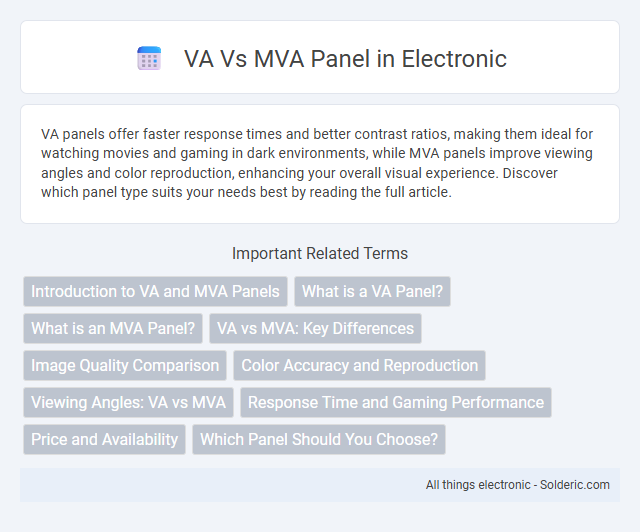VA panels offer faster response times and better contrast ratios, making them ideal for watching movies and gaming in dark environments, while MVA panels improve viewing angles and color reproduction, enhancing your overall visual experience. Discover which panel type suits your needs best by reading the full article.
Comparison Table
| Feature | VA Panel (Vertical Alignment) | MVA Panel (Multi-domain Vertical Alignment) |
|---|---|---|
| Viewing Angles | Good (up to 178deg horizontal & vertical) | Improved over VA, wider viewing angles up to 178deg all around |
| Contrast Ratio | High, typically 3000:1 to 6000:1 | Very High, often better or similar to standard VA panels |
| Color Accuracy | Moderate, less accurate than IPS | Better color consistency than VA, suitable for professional use |
| Response Time | Moderate, usually 4-8 ms | Generally similar or slightly slower than standard VA |
| Black Levels | Excellent, deep blacks with minimal light bleed | Very deep blacks, improved uniformity |
| Price | Generally affordable | Higher cost due to enhanced technology |
| Best Use Case | Gaming, movies, everyday use | Professional work requiring better color and viewing angles |
Introduction to VA and MVA Panels
VA (Vertical Alignment) panels deliver high contrast ratios and deep blacks due to their liquid crystal alignment, making them ideal for dark-room environments and cinematic experiences. MVA (Multi-domain Vertical Alignment) panels enhance traditional VA technology by offering wider viewing angles and improved color accuracy through multiple liquid crystal domains. Both VA and MVA panels provide superior contrast compared to IPS panels but differ in viewing angle performance and color reproduction fidelity.
What is a VA Panel?
A VA (Vertical Alignment) panel is an LCD technology known for its superior contrast ratios, deep blacks, and better color reproduction compared to TN panels. This panel type uses liquid crystals aligned vertically to block light when inactive, resulting in richer image depth and improved viewing angles. Your choice of a VA panel enhances multimedia experiences by delivering vivid visuals with minimal color distortion.
What is an MVA Panel?
An MVA (Multi-Voltage Array) panel is an advanced type of electrical panel designed to handle multiple voltage levels simultaneously, optimizing power distribution for complex systems. It integrates various voltage inputs into a single, streamlined interface, improving efficiency and safety in industrial and commercial applications. Unlike traditional VA (Voltage Amperage) panels, MVA panels support diverse voltage requirements, making them ideal for environments requiring robust and flexible energy management solutions.
VA vs MVA: Key Differences
VA (Vertical Alignment) and MVA (Multi-domain Vertical Alignment) panels differ primarily in viewing angles and color accuracy, with MVA offering wider viewing angles and better color reproduction compared to traditional VA panels. VA panels excel in contrast ratios and deep blacks, making them suitable for dark-room environments, while MVA panels provide enhanced grayscale performance and improved image uniformity. These distinctions make MVA panels ideal for professional use requiring color fidelity and consistent image quality across wider viewing positions.
Image Quality Comparison
VA panels offer higher contrast ratios with deeper blacks and richer colors, enhancing image depth and making them ideal for dark-room settings. MVA panels provide a wider viewing angle with less color distortion and better brightness uniformity, improving overall visual consistency from different perspectives. Your choice depends on whether you prioritize contrast quality or viewing angle performance for your display needs.
Color Accuracy and Reproduction
VA panels offer higher contrast ratios but typically have lower color accuracy and reproduction compared to MVA panels, which are designed to improve over standard VA technology with better color consistency and wider viewing angles. MVA panels enhance color depth and gradient smoothness, making them a more suitable choice for tasks requiring precise color fidelity such as photo editing or graphic design. When choosing between VA and MVA for your display, consider your need for accurate color representation to ensure your visual content appears vibrant and true to life.
Viewing Angles: VA vs MVA
VA panels typically offer narrow viewing angles of around 178 degrees horizontally but suffer from color shifting and contrast reduction at wider angles. MVA panels improve upon this by providing enhanced viewing angles with less color distortion and better consistency, making them more suitable for shared or multi-angle viewing. Both technologies maintain strong contrast ratios, but MVA panels strike a better balance between contrast and viewing angle performance.
Response Time and Gaming Performance
VA panels typically have slower response times compared to MVA panels, which can result in more motion blur during fast-paced gaming. MVA panels offer better response times, enhancing your gaming experience by reducing ghosting and providing smoother visuals. Choosing an MVA panel is ideal for gamers seeking improved performance and quicker pixel transitions.
Price and Availability
VA panels typically offer a more affordable price point compared to MVA panels, making them popular for budget-conscious consumers. MVA panels may cost slightly more due to enhanced color accuracy and better contrast ratios, but both panel types are widely available in the market. Availability for VA panels tends to be higher across various manufacturers, while MVA panels are commonly found in specialty monitors and mid-range devices.
Which Panel Should You Choose?
When choosing between VA and MVA panels, consider that VA panels generally offer deeper contrast ratios and better black levels, making them ideal for watching movies or gaming in dark environments. MVA panels provide wider viewing angles and improved color accuracy, which enhances your experience in brightly lit rooms or when multiple viewers are watching. Your decision should prioritize whether contrast performance or color consistency and viewing angles matter most for your specific use case.
VA vs MVA Panel Infographic

 solderic.com
solderic.com